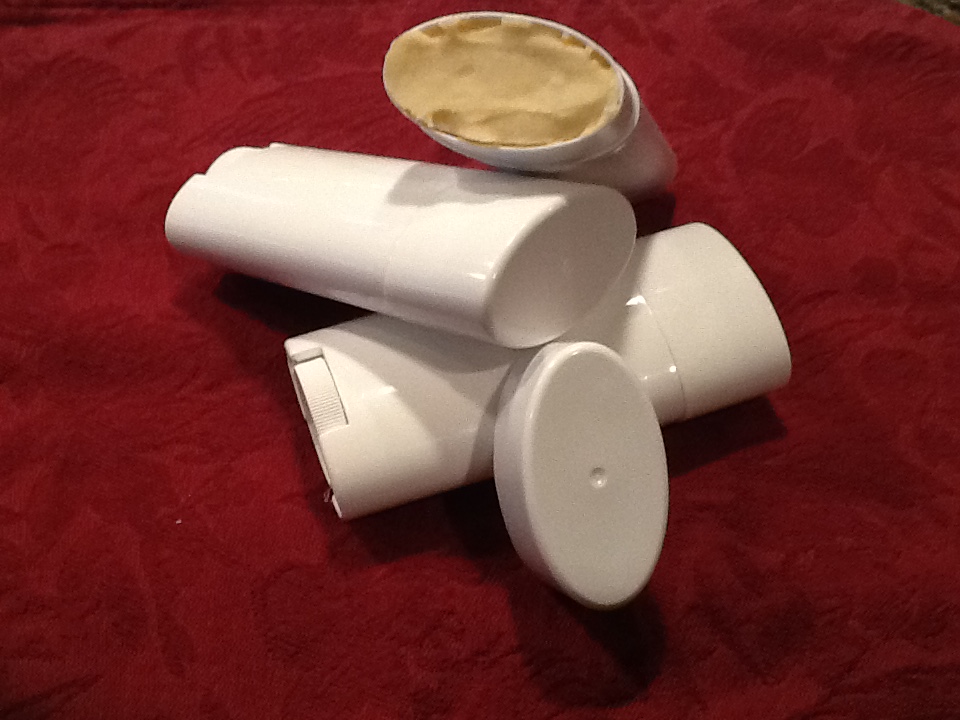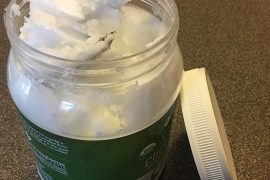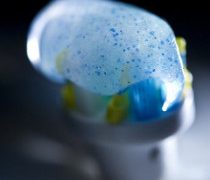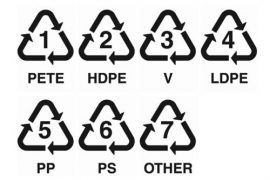Eliminating toxins in your foods and personal care products are a big part of healthy living. You may have stopped using dryer sheets, and conventional cleaning products. But what about your deodorant? Products you use on your skin eventually make their way through your body. They can either have a positive or negative impact on your health depending on what you chose.
To be honest, I stopped using conventional deodorants a long time ago and started making my own. The use of perfumes and toxins in deodorants aren’t necessary and it’s not healthy. In addition to the potential toxic ingredients, by applying conventional deodorants you are clogging your pores with chemicals that stop your body from what it naturally needs to do….cool off, sweat out toxins and breathe.
Common ingredients in deodorants
While the variety of ingredients in deodorants varies based on the product, here are six common ingredients you may find in your deodorant.
Aluminum-This ingredients prevents the body from sweating by blocking the pores. This ingredient is linked to breast cancer and Alzheimer’s. (1,2)
Fragrance-Fragrances are often petroleum based and contain phthalates which disrupt hormones. It’s virtually impossible to know what chemicals are used in “fragrance” or “perfume” because scents are protected by trade law. Fragrance can cause skin irritation, respiratory distress and allergic reactions.
Parabens-(methyl, ethyl, propyl, benzyl and butyl) These chemicals are used as preservatives in deodorants. The concern is that parabens can mimic estrogen and interfere with the way the body produces and regulates estrogen and other hormones. This 2012 study found one or more parabens in 99 percent of the tissue samples collected from 40 mastectomies. (3)
Phthalates-This chemical helps products stay on your skin. Studies have linked this chemical to respiratory problems, hormonal imbalances and eczema.
Propylene Glycol-This chemical is used to maintain moisture in deodorants. It is also a petroleum based product and used in anti-freeze. It is linked to allergic reactions, liver and central nervous system damage. (4)
Triclosan-This chemical is added due to its anti-bacterial properties. Triclosan was first registered as a pesticide in 1969. It is so commonplace in products that the CDC found 75% of the U.S. population had detectable levels in their urine. This antibacterial chemical also forms chloroform, when it comes into contact with chlorinated water. (5,6,7)
It is also important to avoid applying deodorant after shaving your underarms. The skin can be more sensitive and any cuts will allow whatever you’re applying to be more easily absorbed into your body.
If these ingredients are concerning to you, ditch your conventional products and look for fragrance free, organic or natural deodorants.
11 safer deodorant options
There are many deodorants options available online and in stores. It’s always important to read labels, especially if you notice the packaging or labeling has changed. Due to the expense involved, companies usually only do this when ingredients have changed. Please be sure to read the ingredients of these products, some are certified organic, while others simply use safer ingredients.
Soapwalla-Made with jojoba oil, sunflower oil, shea butter and essential oils.
Primal Pit Paste Natural Deodorant Stick Unscented– Made with aluminum-free baking soda, organic arrowroot powder, organic shea butter, organic coconut oil and Non-GMO vitamin E.
Miessence Ancient Spice Roll On-Made with aloe vera, baking soda, bergamot, lime, frankincense, cinnamon, clove and vanilla.
Purely Pitz–Certified organic. Made with aluminum-free baking soda, beeswax, cocoa butter, coconut oil, cornstarch, jojoba oil, shea Butter, essential oils, and Vitamin E.
For Pits Sake-Made with ingredients like arnica, coconut oil, beeswax and essential oils.
Nourish Organic Deodorant Stick– Certified organic. Made with almond, vanilla, beeswax, cocoa, coconut, fig, lavender, mint and shea butter.
Bubble & Bee Pit Putty–Certified organic. Made with arrowroot powder, coconut oil, aluminum-free baking soda, spearmint essential oil and tea tree essential oil.
Ursa Major No B.S. Deodorant–Made with hops, aloe, enzymes, kaolin clay, chamomile and shea butter.
Schmidt’s Fragrance Free Deodorant Stick-Made with magnesium hydroxide, coconut oil, arrowroot powder, shea butter, jojoba seed oil, candelila wax and vitamin E oil.
Lulu Organics Deodorant Cream Lavender & Clary Sage –Certified Organic. Coconut oil, jojoba oil, nic shea butter, organic non-gmo cornstarch, kaolin clay, baking soda, horsetail, rosemary, comfrey, essential oils, vitamin e, non-gmo lecithin.
Greener Path All Natural Deodorant Lavender-Made with Cocos Nucifera (Coconut) Oil, Sodium Bicarbonate (Baking Soda), Beeswax, Theobroma Cacao (Cocoa) Seed Butter (Organic), Zea Mays (Corn) Starch, Sambucus Nigra Fruit Extract, Carthamus Tinctorius (Safflower) Seed Oil, Vitis Vinifera (Grape) Seed Extract, Tocopherol, Natural Lavender Scent.

Homemade deodorant recipes
There are an abundance of homemade deodorant recipes available online using everyday items from your pantry. Here are two recipes I use:
Homemade Coconut Oil Deodorant
Ingredients :
1/4 cup baking soda
1/4 cup arrowroot powder
5 tablespoons coconut oil
Directions :
1. Combine baking soda and arrow root powder in a bowl and mix with a fork.
2. Start with about 4 tablespoons/one-fourth cup of coconut oil and add the coconut oil to the baking soda mixture, working into a paste.
The deodorant will have somewhat of a play-dough consistency, and will be softer or harder depending on its temperature.
3. You can put the deodorant into a small container with a lid, or into an empty deodorant container. My deodorant hardened somewhat after I put it into a container.
Homemade Probiotic Deodorant
Ingredients
1 Tbsp. cocoa butter
1 Tbsp. coconut oil
1 Tbsp. shea butter
1 Tbsp. beeswax
2 1/2 Tbsp. arrowroot powder
1 Tbsp. baking soda
1/4 tsp. vitamin E oil
2 capsules powdered probiotics
Directions:
1. Melt cocoa butter, coconut oil, shea butter, and beeswax over low heat.
2. Remove pot from heat, then add arrowroot powder and baking soda. Whisk with chopsticks until all powders are dissolved and combined. Add vitamin E oil at this time. Allow mixture to cool in pan. Once it is cooled and the consistency of pudding, open capsules of probiotics and add powder to mixture. Stir with spatula quickly to combine.
3. Add mixture to clean deodorant container. Place in refrigerator to cool and harden. After this, product may be stored on counter (Note: Using a shelf stable probiotic will prevent the need for refrigeration). This recipe will fill container and last for 3-4 months. Remember…a little goes a long way!
Notes
-When choosing a probiotic supplement for this deodorant it is important to find one that is shelf stable. (doesn’t require refrigeration)
Want to see how your deodorant rates?
Check it out on EWG’s Skin Deep Page.
As always shop with your wallet. Manufacturers only make these products because consumers buy them. If product sales drop, manufacturers will either modify or drop the product completely.
References
- Exley, C., Ph.D. (2004, December 15). Aluminum in antiperspirants: More than just skin deep. Retrieved February 13, 2018, from http://www.amjmed.com/article/S0002-9343(04)00694-1/fulltext
- Mannello, F., Tonti, G. A., Medda, V., Simone, P., & Darbre, P. D. (2011, April). Analysis of aluminium content and iron homeostasis in nipple aspirate fluids from healthy women and breast cancer-affected patients. Retrieved February 13, 2018, from https://www.ncbi.nlm.nih.gov/pubmed/21337589
- Barr, L., Metaxas, G., Harbach, C. A., Savoy, L. A., & Darbre, P. D. (2012, January 12). Measurement of paraben concentrations in human breast tissue at serial locations across the breast from axilla to sternum. Retrieved February 13, 2018, from http://onlinelibrary.wiley.com/doi/10.1002/jat.1786/abstract
- Al, M., Mebuke, N., & De, G. C. (2011, May). Propylene glycol: an often unrecognized cause of allergic contact dermatitis in patients using topical corticosteroids. Retrieved February 13, 2018, from https://www.ncbi.nlm.nih.gov/pubmed/21611683
- Triclosan Facts | Pesticides | US EPA. (2010, March 24). Retrieved February 13, 2018, from https://archive.epa.gov/pesticides/reregistration/web/html/triclosan_fs.html
- Marshall, N. B., Lukomska, E., Long, C. M., & Anderson, S. (2016, May 01). Dermal exposure to the antimicrobial triclosan affects the gut microbiome and augments Th2 allergic responses mediated through Toll-like receptor 4. Retrieved February 13, 2018, from http://www.jimmunol.org/content/196/1_Supplement/191.21.short
- Anderson, S. E., Franko, J., Kashon, M. L., Anderson, K. L., Hubbs, A. F., Lukomska, E., & Meade, B. J. (2013, March). Exposure to triclosan augments the allergic response to ovalbumin in a mouse model of asthma. Retrieved February 13, 2018, from https://www.ncbi.nlm.nih.gov/pubmed/23192912








